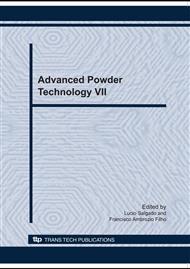p.531
p.537
p.543
p.549
p.555
p.561
p.567
p.573
p.581
Evaluation of the Influence of Process Variables on Flotation of Phosphate
Abstract:
Froth flotation is an adsorptive-bubble separation method based on the selective attachment of particles on the surfaces of gas bubbles passing through a suspension. Reagents as collectors, frothers and pH modifiers are added to perform specific roles to facilitate and to improve the separation. In the present work the process of apatite flotation in column has been investigated experimentally. The influence of the reagents (collector and frother dosages and interactions), percentage of solids and pH value on the column flotation of coarse particles of apatitic ore was analyzed. Percentage of solids was the variable that more influenced on the apatite recovery and the P2O5 grade was more affected by varying pH. The best results were achieved by using lower pH values and lower pulp density. Frother addition only had significant effect for lower collector dosage.
Info:
Periodical:
Pages:
555-560
Citation:
Online since:
October 2010
Keywords:
Price:
Сopyright:
© 2010 Trans Tech Publications Ltd. All Rights Reserved
Share:
Citation:


